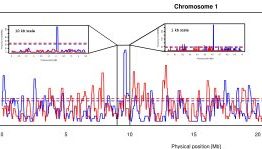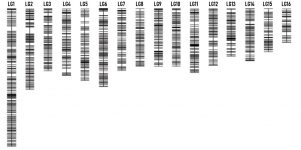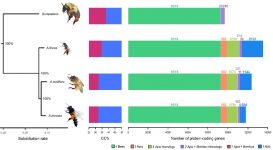Honey bees have the highest meiotic recombination rate among multicellular organisms. Several hypotheses exist to explain why these extraordinarily high rates of chromosome exchanges happen in honey bees and some other social insects. However, we need more information to satisfactorily answer this question. We are interested in generating and analyzing genomic data from other species of honey bees and social insects to explore the link between high recombination rates and social evolution. In addition, we like to know how variable and environmentally responsive the recombination rate within the species Apis mellifera is. We complement these studies with efforts to elucidate the mechanisms of meiotic recombination in honey bees. Studying the mechanistic changes that allow the high rates of crossovers between honey bee chromosomes may allow us to better understand the process of meiotic recombination and its regulation in general, with potential human health implications.
 |
 |
 |
Takata M., Takahashi M., Ishibashi T., Tasaki E., Rueppell O., Vargo E.L., Matsuura K. (2025) Transgenerational epigenetic effect of kings’ aging on offspring’s caste fate mediated by sperm DNA methylation in termites. Proc. Natl. Acad. Sci. USA, 122: e250950612.
Fouks B., Miller, K.J., Ross C., Jones C., Rueppell O. (2025) Alternative double strand break repair pathways shape the evolution of high recombination in the honey bee, Apis mellifera. Insect Molecular Biology, 1-18.
DeLory T., Romiguier J., Rueppell O., Kapheim, K.M. (2024) Recombination rate variation in social insects: an adaptive perspective. Annual Review of Genetics 58,7.1–7.23.
Waiker P., de Abreu F.C.P., Luna-Lucena D., de Paula Freitas F.C., Simoes Z.L.P., Rueppell O. (2021) Recombination mapping of the Brazilian stingless bee Frieseomelitta varia confirms high recombination rates in social Hymenoptera. BMC Genomics, 22:673.
Fouks B., Brand P., Nguyen H.N., Herman J., Camara F., Ence D., Hagen D.E., Hoff K.J., Nachweide S., Romoth L., Walden K.K.O., Guigo R., Stanke M., Narzisi G., Yandell M., Robertson H.M., Koeniger N., Chantawannakul P., Schatz M.C., Worley K.C., Robinson G.E., Elsik C.G., Rueppell O. (2021) The genomic basis of evolutionary differentiation among honey bees. Genome Research, doi: .
DeLory T., Funderburk K., Miller K., Zuluaga-Smith W., McPherson S., Pirk C.W., Costa C., Weinstein-Teixeira E., Dahle B., Rueppell O. (2020) Local variation in recombination rates of the honey bee (Apis mellifera) genome among samples from six disparate populations. Insectes Sociaux, 67(1): 127-138.
Rueppell O., Kuster R. , Miller K. , Fouks B., Rubio Correa S., Collazo J., Phaincharoen M., Tingek S., & Koeniger N. (2016) A new metazoan recombination rate record and consistently high recombination rates in the honey bee genus Apis accompanied by frequent inversions but not translocations. Genome Biology and Evolution, 8(12): 3653-3660.
Ross C., DeFelice D., Hunt G., Ihle K., Amdam G.V. & Rueppell O. (2015) Genomic correlates of recombination rate and its variability across eight recombination maps in the Western Honey Bee (Apis mellifera L.). BMC Genomics, 16:107.
